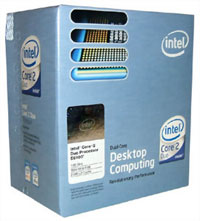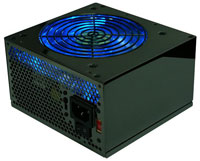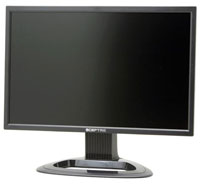Upgraded Midrange Configuration
We've covered our basic recommendations, but of course there's a lot of fine tuning that can be done. The price bracket that can be defined as being midrange is pretty large; some people feel midrange is closer to $1000 while others feel it's closer to $2000. We would say $2000 is more of a high-end configuration, but as we mentioned earlier you don't need to purchase every upgraded component when customizing your own midrange build. Here then are the upgraded midrange recommendations.
| Intel Mid-Range Performance System |
| Hardware |
Component |
Price |
Rebates |
| Processor |
Intel Core 2 Duo E6600 (2.40GHz 4MB Shared) - Retail |
$317 |
|
| Motherboard |
ASUS P5B-E (P965 775) |
$151 |
|
| Memory |
Super Talent 2x1GB DDR2-800 (T800UX2GC4) |
$268 |
|
| Video Card |
Sapphire Radeon X1950XT 256MB (100186L) |
$256 |
$30 |
| Hard Drive |
Western Digital 500GB SATA 3.0Gbps 7200RPM 16MB (Caviar SE16) |
$148 |
|
| Optical Drive |
LG Black 18X DVD+R (GSAH22N-BK) |
$36 |
|
| Case |
Lian Li PC-7B plus II |
$103 |
|
| Power Supply |
Rosewill SLI 600W (RP600V2-S-SL) |
$73 |
|
| Display |
Sceptre x22wg-Gamer 22" 5ms DVI+HDMI (1680x1050) |
$365 |
$20 |
| Sound Card |
Creative Sound Blaster X-Fi XtremeGamer 7.1 |
96 |
|
| Speakers |
Logitech Z-5300e 5.1 280W THX Speakers |
$159 |
|
| Keyboard and Mouse |
Microsoft Comfort Curve 2000 B2L-00047 |
$28 |
|
| Operating System |
Windows XP MCE 2005 (with Vista coupon) |
$115 |
|
| Bottom Line |
|
$2115 |
$2065 |
 |
As you can see, we've limited our performance upgrade to the Intel platform. AMD is still be reasonably competitive with the E6600 when using their X2 5000+, but we definitely give the edge to Intel and the prices of those two processors are about the same. A few of the less critical components stayed the same, but we've upgraded almost everything.
The upgraded processor improves clock speed over the E6300 by 28%, and the 4MB L2 cache typically adds another 5% to 15% performance depending on the application. It ends up being about 40% more processor performance for a price increase of 70%, which really isn't that bad in terms of CPU price/performance scaling.
The ASUS P5B-E motherboard isn't going to be noticeably faster than the Biostar 965PT, but it does have some extra features. The ASUS board adds FireWire support, three more internal SATA ports and one eSATA port, RAID 0/1/5/10 support, a slightly different expansion card slot arrangement, and a different onboard audio solution. The ASUS P5B-E is also one of the better overclocking motherboards, especially in its price bracket.
Along with the faster processor and upgraded motherboard, we selected some Super Talent DDR2-800 memory with 4-4-3 timings. The performance benefit of the faster memory probably isn't worth the extra $40 ($70 after OCZ rebate) unless you plan on overclocking, and we will be using this same memory on the overclocking configuration. These Super Talent DIMMs allow for up to 2.2V officially and should come close to matching the performance of many of the $400+ memory kits. Timings will likely need to be relaxed a bit more, but overall they are very good DIMMs.
 |
There are quite a few good graphics cards in the $200-$300 price range, and for the performance configuration we selected one of the faster models. The X1950 XT 256MB is nearly as fast as the full X1950 XTX in most situations, but it's priced about $100 lower. There are a few games and applications that can benefit from having 512MB of memory, but even then the performance difference is rarely more than 10% so the 40% price increase is hard to justify. Anyone interested in running a CrossFire setup would need to choose a different graphics card, as there are no 256MB X1950 XT CrossFire cards right now, but we wouldn't recommend CrossFire or SLI as a reasonable gaming solution unless you are already running at least a GeForce 8800 GTS or faster graphics card.
 |
The hard drive, power supply, and display upgrades all take the same approach: bigger is better! If you're not the type of person to fill even a 250GB hard drive, obviously the hard drive upgrade is unnecessary. The Rosewill 600W power supply is probably overkill, but users who plan on adding multiple hard drives and perhaps a second graphics card in the future probably won't feel too bad about spending an extra $10. Whether or not the Rosewill 600W is really that much better than the Fortron Source 450W is debatable, but most people have been pretty pleased with the midrange Rosewill offerings. Just be aware that they aren't particularly quiet.
 |
The 22" LCD has the same resolution as the 20" LCD in our base configuration, but it does have a few other advantages. The Sceptre x22wg-Gamer boasts a 5ms response time (versus 8ms), but more importantly it includes HDCP support and it also has an HDMI input. Acer offers a couple of similar 22" LCDs that are worth considering, and if you are primarily concerned with image quality we would rate them as being more or less equivalent to the Sceptre (most of the 22" LCDs use the same panel after all). For $50 less you can forget all about HDCP support and just get a standard LCD, or you can save $20 and still get HDCP but drop the HDMI port. Several other companies offer similar LCDs, with prices ranging from $300-$400, but if you want to get something larger than a 22" LCD the next step up will be the 23" and 24" models that cost at least twice as much. We'll save such displays for the High-End Buyer's Guides.
 |
The last two upgrades are a change of case and improved audio, neither of which are truly a critical upgrade. The Lian Li cases do look nice and they are invariably very high-quality designs, and the PC-7B Plus II has been popular for quite some time. Unlike the basic case, the Lian Li features an aluminum construction that reduces the weight and helps to avoid sharp edges on the interior. It also comes with two 120mm fans which should help to provide exceptional cooling for all but the most demanding builds. The drawback of the two fans is that they do tend to create more wind noise, but you can always unplug the front fan if that's a concern.
 |
As for the speakers, the Logitech Z-5300e speakers certainly sound better than the cheaper Logitech X-530, but they also take up more space. The subwoofer in particular is very large (as is the remote), and for many environments the sound output may be overpowering. There's also no point in investing in really nice speakers if you don't intend to use a higher-quality soundcard, which is why we've included the Creative Sound Blaster X-Fi XtremeGamer. The X-Fi will primarily help in gaming applications, but it does provide cleaner audio than onboard solutions as well. Multimedia enthusiasts might also be interested in adding a TV tuner card, in which case we would look towards either the NVIDIA DualTV, ATI Theater 650, or one of the Hauppauge offerings.
Altogether, the various performance upgrades add almost $800 to the total cost. We do feel that every one of the upgrades is justifiable, but most people probably aren't looking to spend upwards of $2000 on a new computer. This is definitely a high-end configuration rather than a midrange system, but we wanted to give a list of good potential upgrades without drifting off into long-winded debates about which upgrades are the most important. If you want a good start to a high-end computer, you can of course take this list and run with it you will be very pleased. If you want more of a middle ground, the speaker, case, motherboard, and memory upgrades are the first areas we would look to trim costs.


















43 Comments
View All Comments
Mermaidman - Friday, August 31, 2007 - link
Come on guys, my AMD Barton is getting long in the tooth and UT2007 is around the corner! :)Sunrise089 - Sunday, January 21, 2007 - link
Jarred:Thanks again for another stand-out article. Despite what other may chime in (and the usual complaints by the PSU nazis that want us to spend more on a commodity component then a CPU or motherboard) this new system makes MUCH more sense than having many AMD and Intel options for what had basically become guides based on personel preference rather than rational performance. There is no reason to choose AMD for certain applications, overclocking one of them, just as there is no reason to choose Intel in others (say a sub $100 CPU). Just coming out and saying that through a build list is a wonderfull step in the right direction. I think it's crazy that users still insist on an all AMD or all Intel series of builds, when noone insists on all ATI or all nVidia.
In short, it makes much more sense to break up the builds based on the very different usage requirements - especially due to some users not OC'ing and therefore having totally different CPU, motherboard, and HSF needs than an arbitrary division of the guides based on CPU brand.
Keep up the good work!
SaII - Sunday, January 21, 2007 - link
This article has all the PSU configs wrong, get at least a GOOD branded PSU for an 8800GTSand that 700W PSU for the overclocking config is over the top over-kill.
Give the overclocking one the OCZ 600W PSU and 700W OCZ for the gaming rig.
JarredWalton - Sunday, January 21, 2007 - link
I'd say if you want a really good PSU for overclocking or gaming, plan on spending around $120 or so, which will get you the 700W OCZ listed or a variety of other high-quality 500-600W PSUs. I will take the PSU complaints under consideration next midrange guide, but seriously for gaming (WITHOUT overclocking), the only thing that really needs more than a good quality 400W PSU is going to be SLI/CrossFire setups, and even then 400W is usually enough.sirdowny - Sunday, January 21, 2007 - link
Just out of curiosity, has anyone heard about any problems with the Tuniq Tower 120 and it's massive weight? Seems like it would be a good cooler assuming it were used in a case that sat horizontally (like an HTPC), but am I the only one who has reservations about letting that brick dangle from my motherboard?SaII - Sunday, January 21, 2007 - link
I have it, it works wonders, and the only ones that have problems is user error.Zepper - Saturday, January 20, 2007 - link
Things author should know:1- Rosewill is one of Newegg's in-house packagers. Some folks won't or can't buy from Newegg/ChiefValue which is (I say is because they are the same company) the only place you can get the Rosewill brand except for perhaps some Mom & Pop shops who may buy stock from them.
2- Who actually makes that PSU so the folks referred to above can get one if they want (not that they would when such a unit as the Enhance ENP-5150GH exists with aPFC and full-range AC auto sensing is available for nearly the same money). In most cases Rosewill packages ATNG/Coolmax PSUs - if this IS a Deer then it should NEVER have been recommended - its output ratings are identical to the Coolmax 600 but the physical layout is not.
In any case, recommending Rosewill comes with risks - not the least of which is becoming a laughing stock in the community (again, if this is really a Deer then that might be well deserved). They do package some decent products like the R6A and R560x case lines - but unless you know the history of the OEM of the item, it's a pig-in-a-poke. Caveat emptor!
..bh.
Le Québécois - Saturday, January 20, 2007 - link
Are they really rebranding Deer PSU now? Do you know if any other brand use Deer as base PSU?This is the worst know brand I can think of. When I worked as a technician in a computer store, every time someone brought us a computer with a broken Deer PSU inside, almost every components of the computer had blown at the same time the PSU did. Using Deer PSU in a computer is almost like putting a time bomb in it.
mostlyprudent - Saturday, January 20, 2007 - link
Anyone know whether one of the basic configurations (AMD or Intel) from this article would perform better for a system running primarily Photoshop? I had configured two systems for a friend which are very similar to those in this article and was going to let them decide based on price and the general performance difference between the X2 3800 and E6300. It will basically be a web/email/document PC with the exception of a prosumer Photoshop user.JarredWalton - Sunday, January 21, 2007 - link
Core 2 Duo will typically be a bit faster in Photoshop, although in my opinion having a lot of RAM is more important for most professional PS work. Now if we can just get a 64-bit PS version so people can effectively use 4+ GB of memory.... :)